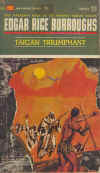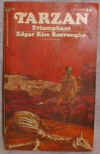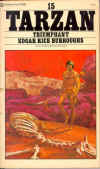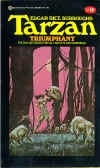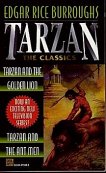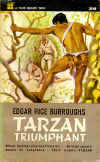More than likely it
is coincidence that as Burroughs wrote a fictional account of time and
space weaving a web, in his own life at this time Fate was bringing together
threads and strands of the web of his own life in a picture of unparalleled
opportunity and deadly peril. The decisions Burroughs would make
would determine the outcome. His life could have gone another way.
Or, perhaps, Burroughs sensed the impending crises and fictionized them
in an attempt to deal with them.
We are already aware of the conflicts
with the Judaeo-Communists. It seems clear that both parties were
the original aggressors and that Burroughs was in reaction to them.
Thus these first two Tarzan novels of the thirties are direct attacks on
both aggressors. If Burroughs expected counter attacks there seems
to be no evidence that he prepared for them. He never seems to have
sat down to coolly analyze the problem in order to have a plan.
If fact, there seems to be little
evidence that he ever actually realized the consequences of his success
or how to handle it. While he had incorporated himself he made no
effort to corporately structure his writing enterprise. In point
of fact as a creative artist he was fundamentally incapable of running
a structured business. Doing so would have interfered with his creative
function. In fact, I am convinced that he dissipated his creative
energies by becoming involved in business decisions to the extent he did.
Developing an organization is
very difficult. While he should have done this, without a very fortuitous
combination of circumstances it is very doubtful he could have. Hollywood
was full of sharpers ready to take advantage of creative talent and in
his case they did.
On the positive side, from 1911
to, say, 1928 ERB had created an unparalleled intellectual property in
Tarzan. One in a zillion chance. As the twenties developed
unparalleled opportunities to exploit that property evolved.
Apart from publishing, the three
key profit centers were comics, movies and radio. All three strands
came to fruition as the thirties began. Each required a slightly
different approach. Each required more thinking out with an intellectual
departure from the past.
At this crucial moment ERB's
past arose to drag him down from behind. He was unable to make the
emotional transition from what was essentially an emotionally battered
youth to a successful, affluent man in control of his destiny. He
remained psychologically attached to his personal relationship to Tarzan
as an aspect of his personality rather than objectifying the character
as a psychological projection for the world. He had prepared the
way to make Tarzan a savior man-god but then couldn't separate him from
his own personality. If Fate had thrown the right people in his way
they could have done this for him.
Thus rather than maximize his
financial returns he essentially shot his feet off. He carped at
the various media companies to the point where he was viewed as troublesome.
Thus while he expected great financial returns including the means to buy
a yacht, he sabotaged his own efforts to obtain them.
He belittled the returns of the
comic strip for instance, bemoaning that it only returned thirty dollars
a day. Well, that was eleven thousand dollars a year, every year.
He could count on it. His MGM contract for Tarzan, The Ape Man
provided him the exact same return. Twenty-two thousand divided by
two years is eleven thousand a year.
At the time ERB signed the MGM
contract he had a very valuable intellectual property already fully developed
but he had developed a reputation among the Studios. The Studios
had already had extensive dealings with him from the silent era.
ERB, without a plan to market Tarzan had accepted whatever money came his
way. Two of his titles had been sold in 1921 although production
on them had been shelved. In 1925 FBO Studios decided to film Tarzan
And The Golden Lion. While this film was lost for decades a print
of the film was discovered which was issued on DVD in 2006 so that it can
now be viewed.
In my opinion FBO did handsomely
by ERB. A good clear scenario was written by William Wing that remained
true to the spirit of Burroughs' work; perhaps more than it ought to have
in a movie sense. The filming, the photography is terrific; it has
never been done better, not my MGM, not by RKO. It is true that Wing
invented a sister for Tarzan but this is a minor point.
I find it difficult to understand
what ERB was disgruntled about except that another writer was handling
his alter ego. The difference between a movie scenario and a book
is very distinct. There would have been no way to get the entire
convoluted story of Golden Lion on the screen so Wing wisely chose
to develop a variation on the story of the Valley Of Diamonds. Even
so he threw in an earthquake scene a la Jewels Of Opar and jumping
the gap in the tunnel.
If anything his attempt to write
as closely to Burroughs as he did lessened the impact of the film with
some needless clutter. If, in 1935's New Adventures Of Tarzan
for which Burroughs provided the story idea, Dearholt attempted to tell
the story more or less as Burroughs wrote, then the result was a hopeless
mish mash. The movie was no truer to Burroughs' Tarzan than FBO's
film, while lacking the clarity and force of the latter. Burroughs
should have been grateful to FBO for an excellent movie. My idea
of the best of the lot even though silent.
Had I been associated with FBO
I would have found ERB's criticisms offensive. The FBO movie triggered
a response from Universal which held the rights to Jungle Tales
and Jewels Of Opar. These titles were released as Tarzan The
Mighty and
Tarzan The Tiger starring Frank Merrill. At
present there is no print of Tarzan The Mighty while as of December
5, 2006, I am still awaiting the release of Tarzan The Tiger.
ERB once again was unhappy with these films, voicing loud complaints.
All this carping could have done little for his reputation among the Studios.
Before the long hiatus in Tarzan movies from 1921 to 1927 he had been run
off the lot during the filming.
According to the ERBzine
Timeline for the '30s ERB approached MGM in 1930 asking $75,000 for
a movie and was rebuffed. If this is true, $22,000 in 1931 was quite
a comedown. MGM solved ERB's querulousness by obtaining the rights
to do with the character as they wished. They promptly disdained
Burroughs' storylines for their own while changing the character of Tarzan
from that of an international sophisticate to that of a feral boy.
As the first full sound Tarzan,
MGM hit the jackpot with the victory cry of the bull ape. The Tarzan
yell would be the trademark of the character, although hardly a blood chilling
fearsome holler. Burroughs himself couldn't do better as Herman Brix
in New Adventures merely growls a long drawn out Tar-man-gan-eee
with the last syllable in falsetto. More laughable than fearsome.
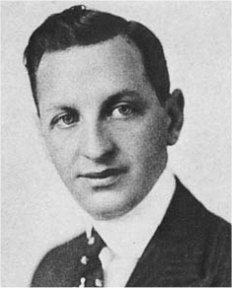 In between these two films Sol
Lesser released a monstrosity starring Buster Crabbe. Lesser
never got the handle on Tarzan on his own, instead borrowing the MGM characterization
when he acquired the rights from them.
In between these two films Sol
Lesser released a monstrosity starring Buster Crabbe. Lesser
never got the handle on Tarzan on his own, instead borrowing the MGM characterization
when he acquired the rights from them.
Lesser
and his brother Irving were independent producers of some substance.
Sol was born in 1890 in Spokane, Washington, dying at 90 in 1980.
There is even a biography of his life. Not easy to find and not available
on any site when I looked. If anybody knows where one is or having
one could make a copy for me it would be much appreciated.
Lesser's father who was
in the nickelodeon business died in 1907 in San Francisco leaving the business
to Sol and Irving. Sol got involved in distribution in 1910 eventually
forming the Golden Gate Film Exchange in 1915.
In that year San Francisco's
infamous Barbary Coast was shuttered. Before the closure Lesser filmed
the area, selling the movie. It would interesting if the film were
still around.
He made the right moves.
After distribution he became a producer for First National and then formed
a chain of movie theatres. After an aborted retirement he reentered
production forming his own independent studio called either Principle or
Principal Pictures. David Fury spells the name Principal in his Kings
Of The Jungle and that sounds right. This was apparently Sol's
status when he acquired the rights to Tarzan from a third party in 1928
and when he made the Crabbe abortion in 1933.
Lesser was influential in Hollywood.
He made it a point to know and be known. In the early thirties it
was he who was responsible for introducing Disney to Joseph Schench (pronounced
SKENK) and facilitating Disney's move from Columbia to United Artists.
One can't be sure of his politics
from the sources cited but according to the New York Times:
...Lesser forsook production for distribution again, returning to the creative
end of moviemaking in 1931 when, through his friendship with writer Upton
Sinclair, he became involved with the Sergei Eisenstein project, Thunder
Over Mexico.
Thunder Over Mexico was undoubtedly
a Communist diatribe. Sol Lesser, while involved with conservatives like
Disney and Burroughs, also played the other side of the street with the
likes of Upton Sinclair and the Jewish-Russian film maker, Sergei Eisenstein
of Battleship Potemkin fame.
It would seem probable that he
at least knew such luminaries as Louis B. Mayer and possibly Irving Thalberg.
Even though he could have foiled both Burroughs and MGM with his prior
rights to Tarzan, he characteristically stepped aside, for remuneration
of course, to let their film play through. It would be interesting
to know how and why he obtained his rights from a third party and how they
had obtained theirs.
One doesn't know what his relationship
to Mayer and MGM was at this time but it is noteworthy that he acquired
exclusive rights to Tarzan when MGM abandoned the profitable series.
Under Lesser they continued to gross two to three million a picture.
Sound movies should have been
a gold mine for Burroughs if handled properly. Instead through his
impulsiveness and vanity there were at least four competing Tarzans on
the screens from 1930 to 1935. This must have created confusion in
the public's mind, while injuring Burroughs financial returns.
At the time sound brought the
potential of immense movie profits to Burroughs the thread of radio also
came to maturity about 1930. While the evangelists were quick to
capitalize on the potential of radio, Burroughs wasn't far behind.
Perhaps the success of Aimee Semple Mcpherson showed him the way.
As the decade dawned, his eye
turned in radio's direction. By 1932 he was successful in launching
a show. Once again ERB failed to analyze the difference between books
and a new medium. Radio was for him the most lucrative of all his
ventures. His revenues from radio equaled his income from all other
sources combined. This income stream could have continued unabated
through the thirties but, once again, ERB interfered with the show rather
than contributed. Undoubtedly because of his constant carping the
first series was not renewed. A second series was launched which
was also discontinued. From 1935 until his death he was unable to
get on radio again. After his death in 1950 a new series was launched.
Thus, between publishing, comics,
movies and radio ERB was provided opportunities to exploit his great labor
in creating the ultimate intellectual property of the twentieth century
and blew it. The personality forming psychology
of his youth popped up to prevent his realizing his most cherished dreams
in this sphere of his life as it did in his relationship with women.
b.
If ERB had read his Homer at
some earlier time, or possibly, earlier times in his life, it seems evident
that he reread the Odyssey, for sure, at this time. The evidence
is prominent in these five novels, especially Triumphant and City
Of Gold. A text in all five novels is his struggle between the
La aspect of his Anima and that of Jane. Subconsciously he had steered
his love life to this critical juncture where he would have to choose one
and reject the other.
There may have been a fortuitousness
in his choosing to concentrate on the Odyssey at this time.
He was able to capitalize on a number of good story ideas, while on the
other hand, a major storyline of the Odyssey is the examination
of a man's control of his sexual desires. A key story of this aspect
is the story of the seductress Circe. By inducing all men to abandon
themselves to unbridled sexual desire she turns them all into pigs.
A lesson for contemporary times. Odysseus avoids this by having a
pocketful of Moly. Moly is some sort of charm that allows him to
resist Circe's seductions.
Thus Odysseus retains his manly
integrity while securing the release of his crew. The Sirens, Calypso
and the other women are all temptations for Odysseus to abandon his manhood
for the luxuries of sex. He resists them all to return home to Penelope
in Ithaca where she sits lonely endlessly weaving her web.
One can't know directly how Burroughs
read the story or even if the above details registered with him; nevertheless
these five novels are about a man's relationships with women and more specifically
they concern the details of ERB's relationships with women. The story
as told by him is a troubled one.
It would appear that his cherished
Anima image of the previous forty years or so, La of Opar, no longer answered
his needs, so at the end of Invincible Tarzan returns La to Opar.
She and Opar disappear from the oeuvre never to be mentioned again.
In real life perhaps La has been
replaced by Florence who now figures as the Golden Girl. With the
appearance of Jezebel in Triumphant the Golden Girl makes her first
appearance to dominate the stage until Lion Man and the end of this
five novel series.
In Triumphant the Jane
aspect which has been missing for the last couple novels parachutes back
into ERB's life. He marries her off to the stable aspect of his Animus
while pairing the Golden Girl with the low life aspect of his Animus.
Emma had always said ERB was
a low brow so perhaps he found it too unpleasant aping high brow manners
giving up the fight to indulge that aspect of his Animus more familiar
to him.
In this struggle Florence had
been removed from the scene. Back during the writing of this novel
Burroughs quickly opted to join his low life aspect with his sexual desire
for the Golden Girl. His Moly gave out on him. Thus Danny 'Gunner'
Patrick is transformed into Old Timer of Leopard Men while Jezebel
becomes the platinum blonde, Kali Bwana.
Having made the decision to take
the Golden Girl he has to eliminate the Jane aspect which he does in City
Of Gold. Perhaps wavering a trifle in Lion Man he seems
to have created a type of middle Tarzan Anima figure in Rhonda Terry.
While he rejects Naomi/Jane he seems to have misgivings about Balza/Florence
as the Golden Girl.
But, by this time the die had
been cast so that in real life he does leave Emma to begin his life with
Florence as a born again sex hound. As Old Timer in Leopard Men
he says he was entitled to some pleasure in life and by God he was going
to take it.
So, in both his business life
and his personal life his past rose up and bit him in the behind destroying
any chance he had to realize his true desires. I'm afraid I have
to look at the remainder of his life as a failure as he was unable to eliminate
the psychological impediments placed in his way by his early life.
Not that he didn't try.
He appears to have studied psychology trying to find a way through to the
other side of the maze of consciousness. Thus we have the subterranean
passages too dark for anyone to find their way, yet his characters do.
As he searches a way out, the past rises up in the shape of deformed monsters
like the Oparians beneath the Sacred City.
Or the round about way Tarzan
and La found their way out of the lion cage in Invincible to be
betrayed by the Old Man who professed to be true to La. Who was the
Old Man? The shade of the past? David Adams has brought emphasis
to this scene in his review of "The Ancient Dead of the City of Horz,"
itself a dead city on the shores of a dead sea in Burroughs Bulletin #68.
By the writing of The Ancient
Dead, ERB no longer had any hope to escape his past, while at the same
time it was too late.
So, as the matter turned out,
this period from 1930 to 1934 was the final crucial period in ERB's life
where he could have taken control of his destiny. He apparently sensed
that the threads and strands of the web of his life were being brought
together by Fate.
I neither condemn nor advise,
unlike the literary fashion of today. I assume no superior airs,
nor do I have the right to do so, but the fact is that had he been able
to control his sexuality while restraining his impulsiveness, Fate might
have been kinder to him at this juncture. As he was unable to order
his psychology Fate, as it were, laid him low.
The critical junctures were the
impetuous signing with MGM, his abandonment of Emma and his mismanagement
of his radio affairs.
I have now covered four of the
five Tarzan novels of this period. The last, The City Of Gold,
deals with his ferocious sexual needs that destroyed his chances for success.

